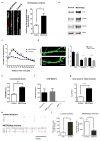Altered neuronal network and rescue in a human MECP2 duplication model
- PMID: 26347316
- PMCID: PMC4720528
- DOI: 10.1038/mp.2015.128
Altered neuronal network and rescue in a human MECP2 duplication model
Abstract
Increased dosage of methyl-CpG-binding protein-2 (MeCP2) results in a dramatic neurodevelopmental phenotype with onset at birth. We generated induced pluripotent stem cells (iPSCs) from patients with the MECP2 duplication syndrome (MECP2dup), carrying different duplication sizes, to study the impact of increased MeCP2 dosage in human neurons. We show that cortical neurons derived from these different MECP2dup iPSC lines have increased synaptogenesis and dendritic complexity. In addition, using multi-electrodes arrays, we show that neuronal network synchronization was altered in MECP2dup-derived neurons. Given MeCP2 functions at the epigenetic level, we tested whether these alterations were reversible using a library of compounds with defined activity on epigenetic pathways. One histone deacetylase inhibitor, NCH-51, was validated as a potential clinical candidate. Interestingly, this compound has never been considered before as a therapeutic alternative for neurological disorders. Our model recapitulates early stages of the human MECP2 duplication syndrome and represents a promising cellular tool to facilitate therapeutic drug screening for severe neurodevelopmental disorders.
Conflict of interest statement
The authors declare no conflict of interest.
Figures




References
-
- del Gaudio D, Fang P, Scaglia F, Ward PA, Craigen WJ, Glaze DG, et al. Increased MECP2 gene copy number as the result of genomic duplication in neurodevelopmentally delayed males. Genet Med. 2006;8:784–792. - PubMed
Publication types
MeSH terms
Substances
Grants and funding
LinkOut - more resources
Full Text Sources
Other Literature Sources

